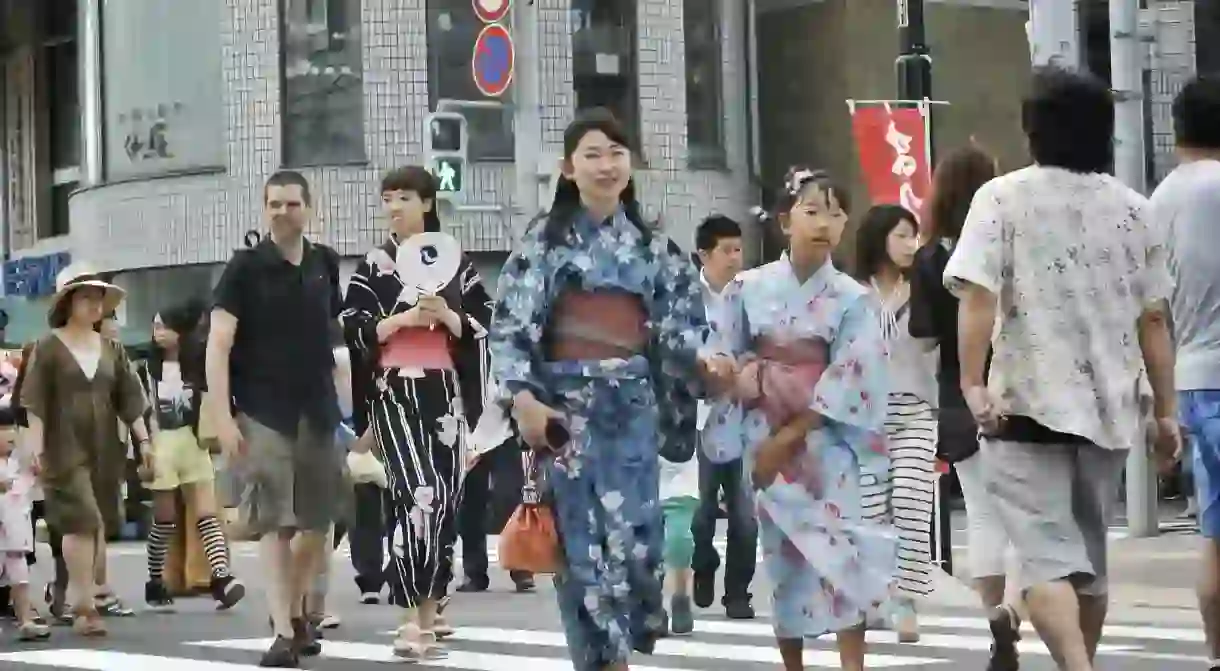What to Wear in Japan in Summer

Summer is a tricky season to prepare for in Japan, thanks in large part to the high levels of humidity and rapidly shifting weather changes. However, the nation is arguably one of the most well dressed in the world, so trying your best in the fashion department is never unappreciated. To prepare for the hot, wet and fashion-forward, here’s a guide to planning what to jam into that suitcase.
Wide-leg pants
After years of being told smaller is better, Japan has gone the other way in terms of silhouettes, opting for wide, baggy clothing that’s comfortable, stylish and practical. Fashion wise, the country is adventurous, but it’s still rather conservative when it comes to skin exposure, which is why you notice that even in summer you’re more likely to see men and women sporting loose-fitting, full-length, wide-leg pants than tiny short-shorts. They’re an excellent and breezy summer-friendly option if you’re nervous about showing off tattoos or appearing disrespectful while visiting shrines and temples.
A post shared by UNIQLO ユニクロ (@uniqlo) on Sep 5, 2017 at 3:18am PDT
Breezy, higher neck t-shirts and blouses
Similar to the wide-leg pants, trendy oversized blouses and t-shirts are a little more conservative and offer a much needed sense of comfort and breathability on longer, sweltering 35°C (95°F) days. Given the incredible humidity, quick-drying shirts made of cotton are the best bet. Of course, you should feel comfortable wearing whatever you’d like, but if you want to follow the crowd, then showing off a plunging neckline is usually saved for late-night attire.
Sneakers
When it comes to exploring Japan, a lot of walking is a given. Even in well connected cities like Tokyo, Kyoto and Osaka, the fastest, best way to explore is typically by foot, especially in summer when the trains are packed with hot, sweaty commuters. For this reason, a pair of supportive, light sneakers is a very worthwhile investment. Luckily, Japan is a nation with one of the highest populations of sneakerheads, so if you’re looking for a little fashion inspiration, you’ll surely find it here.
https://www.instagram.com/p/BmcWQVYnVhQ/
Oversized bag
Once you arrive in any major Japanese city, one of the first things you’ll notice is the absence of garbage bins on the street. Apart from the PET bottle-specific bins next to the occasional vending machine, finding somewhere to put your garbage is difficult, so it’s common just to carry it with you until you get home. For this reason it’s worth planning ahead and bringing a larger than usual bag with you so you can spend more time exploring the cities and less time trying to hunt down a trash can like some strange bin-hungry Pokemon hunter.
Slides / slippers
Packing a stylish pair of slides is not only a good idea if you plan to go to the beach (of which Japan has plenty, and they’re incredible), but they’re also handy because regular shoes are a no-go in the house. Wearing shoes in almost any home is close to one of the rudest things you can do. This no-shoes rule also applies to the occasional public spaces like some restaurants, more traditional office spaces, at public baths, inside temples and in classrooms. Most places that require you to take off your shoes will have public slippers that you can borrow; however, if you’re not too sold on the idea of wearing a pair of old communal slippers, it’s best to bring your own.

Poncho
Summer in Japan is an incredibly temperamental season, and one very prone to the surprise typhoon, so always carrying a poncho is a smart move. You can easily find disposable ponchos in many convenience stores, but bringing your own studier, reusable poncho from home will save you money and is a handy way to alleviate your impact on the environment a little while visiting this plastic-loving society.
Yukata
Summer is one of the busiest times of the year on the social events calendar in Japan. Typically kicking off in mid-late July and running all the way through to August is when cities across the nation hold their biggest public street festivals known as matsuri.
Some of the biggest events include the Kyoto Gion Matsuri, a week-long party that runs for a week starting in mid-July and features live performances and parades. In Tokyo, there’s the Koenji Awa-dori dance festival which sees a million spectators make their way to the neighbourhood of Koenji to watch dance teams battle it out. Meanwhile, Yokohama Sparkling Twilight is a large-scale fireworks festival along the bay.
If you want to fit in with the festival crowd, consider picking up a yukata: a summer version of a kimono worn by both men and women. It’s a casual piece of traditional Japanese clothing loved by locals young and old. The yukata is loose, breezy, easy to wear and comes in an endless selection of fashionable prints. Compared to the kimono, they’re also very affordable – Uniqlo sell them for about 2,000 to 6,000 yen (US$18-54).

Tenugui
Deceptively simple, a tenugui is a piece of fabric, around 30 centimeters wide and around a meter long, typically featuring eye-catching colours and prints. An everyday staple item in Japan, the name tenugui (手拭い) originates from the Japanese words for ‘hand’ and ‘wipe’. It’s used for countless purposes: cleaning, wrapping gifts, decoration, but in the hot summer months it’s a common fashion staple. Made of lightweight cotton, it can be worn as a headband or scarf while doubling as a small towel perfect for dabbing sweaty brows on a humid day. Ubiquitous and cheap, you can pick up a tastefully designed tenugui for around 100 yen (US$1) from a Daiso (Japanese dollar store). They also make excellent last-minute gifts.














